In the Moment:
Michael Frye's Landscape Photography Blog
by Michael Frye | Sep 11, 2015 | Night Photography
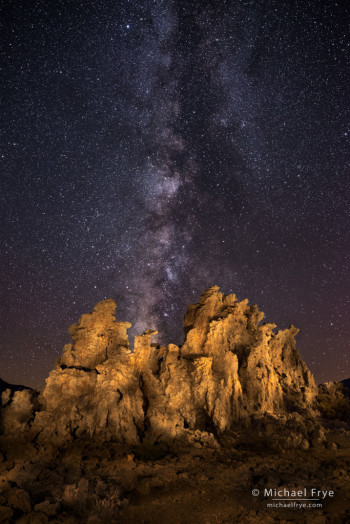
Tufa and Milky Way, Mono Lake, CA, USA
The last few weeks have been very busy. We just finished our Bodie workshop, which was tremendous fun. I’ll post some images from the workshop when I get a chance to process them, but in the meantime here’s a photograph from last Saturday, just before the workshop started.
I wanted to photograph at South Tufa at Mono Lake, but was worried that it would be too crowded, since it was Saturday on Labor Day weekend. And when Claudia and I pulled into the South Tufa parking lot at sunset we were astonished at the number of cars: the entire, large parking lot looked full.
We managed to find a place to park, and headed out to the lake, figuring that since it was getting dark most of the people would leave soon. And indeed, the place emptied out quickly, except for a few photographers intent on night photography. By ten o’clock, when I made this image, there were only three other people around – all photographers of course.
(more…)
by Michael Frye | Nov 25, 2014 | Night Photography
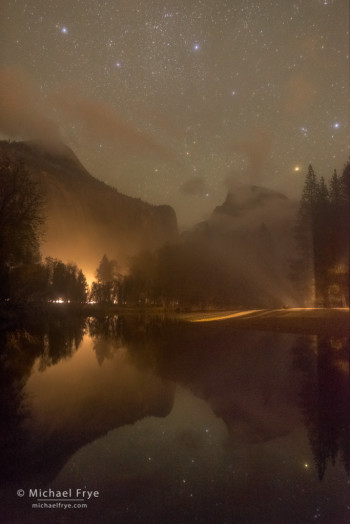
Half Dome, North Dome, and the Merced River at night, with illumination by car headlights, Yosemite
It rained here on Friday night and Saturday morning. The storm cleared Saturday afternoon, so once again I drove up to Yosemite Valley. Unfortunately clouds closed in and muted the light at sunset, but I decided to wait. I remembered a dusk photograph I made from Tunnel View a couple of years ago (the top image in this post), and thought the same light might occur again.
Well lightning didn’t strike twice, and the dusk light wasn’t that interesting. But again I decided to wait. I knew there wouldn’t be any moonlight, but interesting mist was floating around the valley, and I thought starlight might be enough to illuminate some scenes, with perhaps some additional help from car headlights.
(more…)
by Michael Frye | Sep 2, 2014 | Night Photography
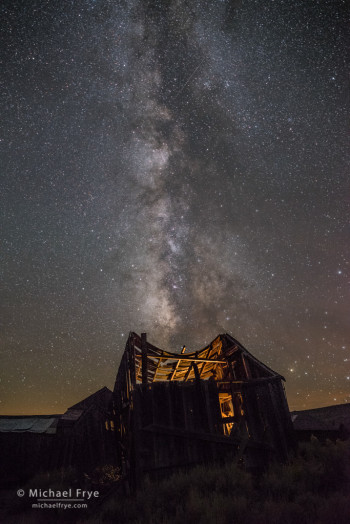
“Swayback” building at night with the Milky Way, Bodie. While helping some members of our group photograph this building I set up my own camera as well. I put tissue paper over a flashlight to act as a diffuser, then stuck my hand through a gap in one of the walls to light the interior of the building during the 20-second exposure for the stars.
As promised, here are some of my recent photographs from Bodie. Bodie, if you’re not familiar with it, is just north of Mono Lake, and is billed as the best-preserved ghost town in the United States. Bodie is now a state park, and a very interesting place to photograph, but it’s usually only open from 9:00 a.m. to 6:00 p.m., which means you can’t photograph it during the best light of the day, much less at night.
A few years ago I was able to photograph Bodie on a moonlit night with Lance Keimig and Scott Martin during one of their workshops. Then, earlier this summer, Claudia and I went to Bodie on one of occasional evenings when the park stays open until 10:00 p.m. This was a moonless night, but since it didn’t get completely dark until about 9:00 p.m. that left only an hour for true night photography. It was still fun, but much too short.
Luckily I would have another chance soon. We had managed to secure a hard-to-get permit to take a workshop group there at night, and added that evening to my Starry Skies Adventure workshop. We had so much fun there with the group. This time we were able to stay until 1:00 a.m., but it wasn’t long enough!
Here’s a selection of both daytime and nighttime images from those recent trips to Bodie. I tried many different ideas, but had to leave other ideas still percolating in the back of my mind, as I just didn’t have time to execute them all. I think there’s so much potential there for creative lighting of both interiors and exteriors, and working with reflections in the old windows. I certainly look forward to going back. If you haven’t been to Bodie, I highly recommend it, even during the middle of the day. And if you get a chance to go in the late afternoon or at night, take it!
— Michael Frye
(more…)
by Michael Frye | Aug 28, 2014 | Night Photography
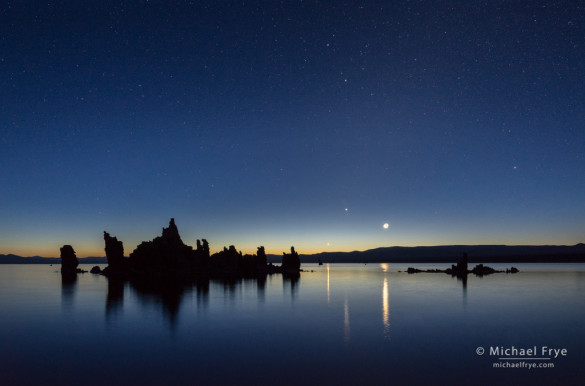
Venus, Jupiter, and the Moon rising at dawn, Mono Lake, Saturday morning
We had a wonderful time during our Starry Skies Adventure workshop last week. We managed to dodge the fires and had four clear, smoke-free nights. It was a really nice group, and photographing under a sky full of stars is always such a great experience.
One of the highlights of the workshop was viewing and photographing a dawn alignment of Venus, Jupiter, and the Moon over Mono Lake last Saturday. It’s hard to convey how gorgeous this was in a photograph, but you’ll find my best attempt above.
We also photographed star trails and the Milky Way, and went to Bodie on our last night. I’ll save the Bodie images for a later post, but you’ll find a selection of other images from the workshop below.
(more…)
by Michael Frye | Aug 16, 2013 | Reviews
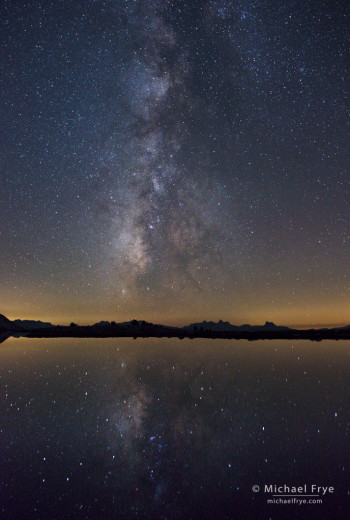
Milky Way reflected in an alpine lake, Yosemite NP, CA, USA. Nikon D800E with 24mm f/1.4 lens; 20 seconds, f/2.8, 6400 ISO
Regular readers of this blog know that I don’t often write about equipment. Equipment is necessary, and important, but not the most important thing in photography.
However, equipment does matter in some situations, like when trying to capture fast-moving subjects, or the faint light of stars, or when you want to make a large print that’s sharp and noise-free.
My regular camera is ancient by the fast-moving standards of the digital age. It’s a 16-megapixel Canon 1Ds Mark II, first introduced in 2004. I haven’t felt a compelling urge to upgrade. Newer models like the Canon 5D Mark II and Mark III have a little higher resolution (21 and 22 megapixels, respectively), but the difference isn’t that significant. They also handle noise better, but again, the advantages are relatively small.
One of the reasons I’ve been slow to upgrade to a new model is because while Canon has been making these modest improvements in image quality, Nikon has been making big leaps. For several years the Nikon sensors (some of which are made by Sony) have outclassed Canon in handling noise – something I could see clearly when looking at student’s photos during workshops. And last year’s introduction of the 36-megapixel Nikon D800 and D800E set a new standard for resolution in a 35mm-style DSLR. All this makes me think about switching, and hesitant to invest in more Canon equipment.
(more…)













